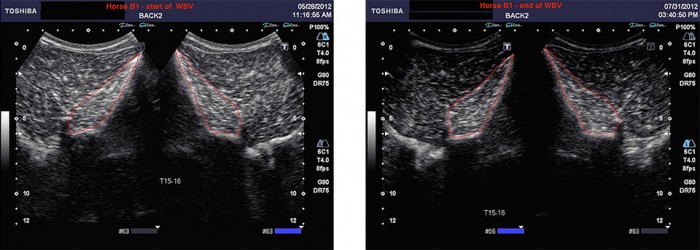
The benefits of whole body vibration for the equine spine
As hypothesized, whole body vibration (WBV) appears to be a viable alternative to dynamic mobilisation exercises as it increases the cross-sectional area (CSA) and improves symmetry of m. multifidus too. With its advantages of low labour demands, not time-consuming and no need for previous practices, WBV can be seen as useful and efficient additional trainingtool.
For humans, WBV already proved its benefits as popular adjunctive therapy. This tool improves the static and dynamic strength plus the size of paraspinal muscles, as well as postural control and back pain problems. This study investigated whether WBV might also be a valuable physiotherapeutic modality in horses. Therefore, nine horses were subject to WBV, twice daily for 30 min, 5 days a week and for 60 days in addition to their regular exercise routine. To evaluate the effect of this intervention, the CSA of the left and right m. multifidus was measured ultrasonographical at four thoracolumbar spine levels (T15–T16, T16–T17, T18–L1and L1–L2) before, during and after the intervention.
Analysis of the results revealed desired changes in the CSA and CSA symmetry (left to right) of the m. multifidus. A significant increase in m. multifidus CSA was found at all spinal levels after 30 and even more after 60 days of WBV and a significant improvement in m. multifidus symmetry (becoming more symmetrical) was found after 60 days of WBV.
Expert opinion by Isabeau Deckers
The whole body vibration becomes more and more well-known as an efficient and useful additional trainings/ therapy tool, not only for human but also for horses. This study confirms its beneficial effects on the health of the equine spine. Its advantages added to these findings, (low labour demands, not time-consuming and no need for previous practices), this tool can be recommended as alternative option to stimulate the core muscles of our equine athletes. Nevertheless, it should be used by purpose only and in combination with an adapted trainings/ rehabilitation program to attain maximal benefits of the equine welfare.
> From: Halsberghe et al., Equine vet. Educ. 9 (2017) 493-499. All rights reserved to Halsberghe BT. Click here for the online summary.


